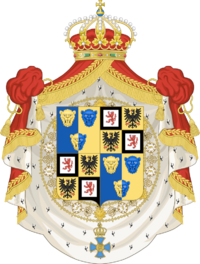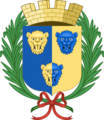Coat of arms of Durland: Difference between revisions
| Line 95: | Line 95: | ||
==Historical coat of arms== | ==Historical coat of arms== | ||
<gallery class="center"> | <gallery class="center"> | ||
File:Coat of arms of Durland (1877-1922).png|Coat of arms of the Principality of Durland (1877-1928) | |||
File:Coat of arms of the Second Durlish Republic (1922-1928).png|Coat of arms of the Second Durlish Republc (1922-1928) | File:Coat of arms of the Second Durlish Republic (1922-1928).png|Coat of arms of the Second Durlish Republc (1922-1928) | ||
</gallery> | </gallery> | ||
Revision as of 17:48, 25 January 2024
| Coat of arms of Durland | |
|---|---|
 Greater (royal) version | |
| Versions | |
 Lesser (state) version | |
| Armiger | Carilla, Sovereign Princess of Durland |
| Adopted | 9 April 1928 |
| Torse | tasseled strings Or |
| Blazon | Per pale Azure and Or two lions rampant all counterchanged within a bordure argent. |
| Orders | Order of Prince Jora |
| Other elements | The monarch places this coat of arms on a mantle gules lined with Ermine. Above the mantle is a pavilion gules again topped with the royal crown. |
The coat of arms of Durland is the arms of dominion of Princess Carilla of Durland, and is used to represent both the monarch and the state. It depicts two lions countercharged onto a vertically-divided shield of blue and gold, within a white border (Per pale Azure and Or two lions rampant all counterchanged within a bordure argent.)
The coat of arms is used by the monarch, Parliament, and the Supreme Court. Members of the Princely Family use the arms charged with a label of difference and a crown of rank. The government uses a variation of the arms, without the mantle and with the shield crowned, which is known as the state arms. The great coat of arms, as used by the monarch, is formally called the Arms of Dominion of Her Highness (Anglish: Seein Aanlauins Arnanreikant).
History
The first coat of arms used by the Principality of Durland, from its establishment in 1876 until the abolition of the monarchy in 1922, was designed by Prince Farnar II. Farnar, an amateur herald and artist, designed the coat of arms originally on the back of an envelope whilst travelling from Nelin to Alduar en route to Herran. The arms were inspired by those of Prince Jora, Grand Prince of the Durlish Principalities, who reigned from 1527 until 1561. The arms, consisting of golden lions on a blue shield, were then countercharged to represent what the prince called "the two Durlands," those being the early modern state of the sixteenth and seventeenth centuries and the modern state of the nineteenth century. The inclusion of a white border (bordure argent) was another creation of the prince. In early modern Durlish heraldry, a bordure represented an adopted son. The prince outlined the meaning of the border in the Durlish coat of arms in a letter to Usror Sode:
This country adopted me. I was neither born here nor raised here and I am, in many ways, still a stranger here. Nonetheless, I remain so very thankful that Durland adopted me. In the arms I now possess, I wanted to show my awareness of this alienness - that my speech may be different and my experiences those of another land, but that I think and feel like a Durl and am dedicated to Durland like any other Durl.
The coat of arms were formally registered with the Court of Arms in 1876, but were de facto used from their creation a year prior.
On the creation of the Order of Prince Jora in 1877, the coat of arms was amended to include the order as a circlet around the escutcheon.
In 1922, following the abolition of the monarchy and the establishment of the Second Durlish Republic, the coat of arms was amended to remove references to the Crown. The new arms featured the escutcheon between two golden laurel branches, crowned with a mural crown. Proposals for a wholly new emblem severing all connection with the previous regime were initially made, but never carried through.
On the restoration of the monarchy in 1928, the coat of arms used from 1879-1922 were briefly revised. In the 1928 constitution, a new coat of arms was established that made small modifications to Farnar's design, with the two lion supporters removed to simplify the design. Provision was also made for a new system of cadency, further elaborated on in the National Symbols (Coat of Arms) Act 1930.
Description
The current coat of arms was adopted in 1928 following the re-establishment of the monarchy. It is closely modelled on the coat of arms previously used from 1878 until 1922. As per the registration with the Court of Arms, the escutcheon is blazoned: Per pale Azure and Or two lions rampant all counterchanged within a bordure argent. The shield is surrounded by the insignia of the Order of Prince Jura, and all surrounded by mantling Gules doubled ermine, crowned with the royal crown and tied up with tassled strings Or.
The rules outlining the design and use of the coat of arms, including variations and eligibility, continue to be based on those made by Farnar II.
Usage
The proper use of the Durlish coat of arms is regulated by law. The National Sybols Act 2003, which updated and consolidated existing legislation relating to the coat of arms, identifies three types of arms used in Durland: the great coat of arms, the state coat of arms, and the shield of arms (or escutcheon).
- The great coat of arms is the arms of dominion of the Durlish monarch, and subsequently serves as the coat of arms of the Sovereign Prince(ss) and also of the state. It is used to represent the Crown and the nation.
- The state coat of arms is the arms used by the government and government entities. It is used to denote a relationship with the state and, in a broader sense, ownership and oversight by the government.
- The shield of arms is the general design of the escutcheon, as used in either the great or state coat of arms or as part of the personal arms of individuals.
The distinction between the great coat of arms and the state coat of arms is not clearly made. The great coat of arms generally represents the monarch and non-executive state institutions (e.g., Parliament, the courts, the armed forces etc.), whereas the state coat of arms represents the government and state. The Durlish passport, as government property, uses the state arms.
Variants
Royal versions
Gallery
- Coats of arms of the Monarch
- Coats of arms of members of the Princely House
- Coat of arms of members of the Princely Family and other variants















